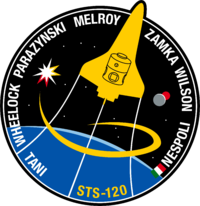-
.
in tv hanno detto che è tutto risolto, speriamoin bene per l'atterraggio . -
forumbiotech.
User deleted
CITAZIONE (Tursiops @ 16/6/2007, 19:16)in tv hanno detto che è tutto risolto, speriamoin bene per l'atterraggio
Già, speriamo vada tutto per il meglio.
. -
.
il lancio dell'Atlantis, STS117:
. -
.
Informazioni generali sullo Space Shuttle:
http://it.wikipedia.org/wiki/Space_Shuttle. -
forumbiotech.
User deleted
QUOTE (Tursiops @ 24/6/2007, 17:04)Informazioni generali sullo Space Shuttle:
http://it.wikipedia.org/wiki/Space_Shuttle
Tursiops, saresti in grado di spiegarmi la foto..?
Lo Shuttle trasportato da un Boeing, è davvero la prima volta che mi capita di vedere una cosa del genere... -
.
Certo Forumbiotech, se non erro lo shuttle viene trasportato a bordo di un aereo perchè solitamente l'atterraggio avviene molto distante dal lancio e dalla base per cui l'unico modo che ha di tornare indietro è quello di farsi trasportare da un aereo non essendo lo shuttle un velivolo di linea 
Penso che sia per questo motivo. -
forumbiotech.
User deleted
QUOTE (Tursiops @ 24/6/2007, 17:20)Certo Forumbiotech, se non erro lo shuttle viene trasportato a bordo di un aereo perchè solitamente l'atterraggio avviene molto distante dal lancio e dalla base per cui l'unico modo che ha di tornare indietro è quello di farsi trasportare da un aereo non essendo lo shuttle un velivolo di linea
Penso che sia per questo motivo
Ah ecco..grazie per la delucidazione..
. -
.:pollo:..
User deleted
volevo farmi una domanda, cos'è il fumo bianco che si vede uscire dai reattori prima della partenza? . -
.
questo non saprei....sarà vapor acqueo? penso che sia un meccanismo per tenere i motori in temperatura costante . -
forumbiotech.
User deleted
QUOTE (Tursiops @ 24/6/2007, 19:00)questo non saprei....sarà vapor acqueo? penso che sia un meccanismo per tenere i motori in temperatura costante
Non vorrei dire castronerie, ma mi sembra di avere sentito lo stesso..
Qualcuno sa che temperature vengono raggiunte al momento della partenza?. -
.
Domani se il tempo lo concederà parte la missione spaziale 120 con a bordo anche 2 donne:
Space Shuttle Discovery is Ready; Weather Remains a Concern
The countdown to launch of space shuttle Discovery on the STS-120 mission is proceeding smoothly at NASA's Kennedy Space Center in Florida, NASA Test Director Steve Payne announced at this morning's countdown status briefing.
"At this point in the count, we're on schedule, our systems are all good and we're in great shape," Payne said, adding that the launch team is not tracking any technical issues.
Image Above: Space shuttle Discovery stands at Launch Pad 39A, where it is undergoing final preparations for launch on the STS-120 mission. The shuttle is protected by the pad's rotating service structure. Image credit: NASA TV
However, the weather forecast for Tuesday continues to pose a threat to NASA's launch plans. Shuttle Weather Officer Kathy Winters reported that the seabreeze could begin developing by the 11:38 a.m. EDT launch time. There is a 60-percent chance that cumulus clouds, showers and a low cloud ceiling could keep Discovery grounded.
Because launch times are earlier each day, the forecast improves slightly for Wednesday and Thurdsday, with a 40-percent probability of weather prohibiting liftoff.
Discovery's crew of seven astronauts arrived in Florida on Friday and have been going through final checklists and preparations for Tuesday's liftoff.
Discovery is scheduled to return to Kennedy's Shuttle Landing Facility at 4:47 a.m. Nov. 6.
(fonte: http://www.nasa.gov )
. -
M111.
User deleted
NASA
Asteroid to Make Rare Close Flyby of Earth January 29
Scientists are monitoring the orbit of asteroid 2007 TU24. The asteroid, believed to be between 150 meters (500 feet) and 610 meters (2,000 feet) in size, is expected to fly past Earth on Jan. 29, with its closest distance being about 537,500 kilometers (334,000 miles) at 12:33 a.m. Pacific time (3:33 a.m. Eastern time). It should be observable that night by amateur astronomers with modest-sized telescopes.
Asteroid 2007 TU24 was discovered by the NASA-sponsored Catalina Sky Survey on Oct. 11, 2007. Scientists at NASA's Near-Earth Object Program Office at the Jet Propulsion Laboratory in Pasadena, Calif., have determined that there is no possibility of an impact with Earth in the foreseeable future.
"This will be the closest approach by a known asteroid of this size or larger until 2027," said Don Yeomans, manager of the Near Earth Object Program Office at JPL. "As its closest approach is about one-and-a-half times the distance of Earth to the moon, there is no reason for concern. On the contrary, Mother Nature is providing us an excellent opportunity to perform scientific observations."
Asteroid 2007 TU24 will reach an approximate apparent magnitude 10.3 on Jan. 29-30 before quickly becoming fainter as it moves farther from Earth. On that night, the asteroid will be observable in dark and clear skies through amateur telescopes with apertures of at least 7.6 centimeters (3 inches). An object with a magnitude of 10.3 is about 50 times fainter than an object just visible to the naked eye in a clear, dark sky.
NASA detects and tracks asteroids and comets passing close to Earth. The Near Earth Object Observation Program, commonly called "Spaceguard," discovers, characterizes and computes trajectories for these objects to determine if any could be potentially hazardous to our planet.
(fonte: http://www.nasa.gov )
Edited by Tursiops - 25/1/2008, 18:31. -
M111.
User deleted
NASA
Near-Earth Asteroid 2007 TU24 to Pass Close to Earth on Jan. 29 - Should be Observable with Modest Sized Telescopes
spacer
Near-Earth Asteroid 2007 TU24 to Pass Close to Earth on Jan. 29 - Should be Observable with Modest Sized Telescopes
Don Yeomans
NASA/JPL Near-Earth Object Program Office
January 22, 2008
Asteroid 2007 TU24, discovered by the Catalina Sky Survey on October 11, 2007 will closely approach the Earth to within 1.4 lunar distances (334,000 miles) on 2008 Jan. 29 08:33 UT. This object, between 150 and 600 meters in diameter, will reach an approximate apparent magnitude 10.3 on Jan. 29-30 before quickly becoming fainter as it moves further from Earth. For a brief time the asteroid will be observable in dark and clear skies with amateur telescopes of 3 inch apertures or larger.
For an interactive illustration of this object's orbit see:
http://ssd.jpl.nasa.gov/sbdb.cgi?sstr=2007+TU24&orb=1
The illustration below is courtesy of amateur astronomer Dr. Dale Ireland from Silverdale, WA. The illustration shows the asteroid's track on the sky for 3 days near the time of the close Earth approach as seen from the city of Philadelphia. Since the object's parallax will be a significant fraction of a degree, observers are encouraged to use our on-line Horizons ephemeris generation service for their specific locations. These personalized ephemeris tables can be generated at: http://ssd.jpl.nasa.gov/horizons.cgi?find_...str=2007%20TU24
Illustration showing the asteroid's track on the sky for 3 days near the time of the close Earth approach as seen from the city of Philadelphia.
Given the estimated number of near-Earth asteroids of this size (about 7,000 discovered and undiscovered objects), an object of this size would be expected to pass this close to Earth, on average, about every 5 years or so. The average interval between actual Earth impacts for an object of this size would be about 37,000 years. For the January 29th encounter, near Earth asteroid 2007 TU24 has no chance of hitting, or affecting, Earth.
2007 TU24 will be the closest currently known approach by a potentially hazardous asteroid of this size or larger until 2027. Plans have been made for the Goldstone planetary radar to observe this object Jan 23-24 and for the Arecibo radar to observe it Jan 27-28 and then Feb 1-4. High resolution radar imaging is expected, which may permit later 3-D shape reconstruction.. -
.

The STS-122 crew entered the International Space Station for the first time after the hatches between the station and space shuttle Atlantis opened at 1:40 p.m. EST today.
Space Shuttle Atlantis and the STS-122 crew arrived at the International Space Station at 12:17 p.m., delivering the European Space Agency's Columbus laboratory and a new crew member to the orbital outpost.
The crews will prepare for the first of three scheduled STS-122 spacewalks and Sunday’s scheduled installation of the Columbus laboratory.
STS-122 Mission Specialists Rex Walheim and Hans Schlegel will perform the spacewalk, set to kick off at 9:35 a.m. Sunday. Columbus, which can accommodate numerous experiments, is scheduled to be attached to the station at 4:25 p.m. Sunday.
STS-122 is the 24th shuttle mission to visit the station. Atlantis is scheduled to return to Earth Feb. 18.
(fonte: http://www.nasa.gov )
Ecco il video:
. -
M111.
User deleted
QUOTE (forumbiotech @ 25/6/2007, 11:51)QUOTE (Tursiops @ 24/6/2007, 19:00)questo non saprei....sarà vapor acqueo? penso che sia un meccanismo per tenere i motori in temperatura costante
Non vorrei dire castronerie, ma mi sembra di avere sentito lo stesso..
Qualcuno sa che temperature vengono raggiunte al momento della partenza?
Nei motori dello Shuttle si raggiungono i 3000°C, fonte U.A.I..
NASA |

